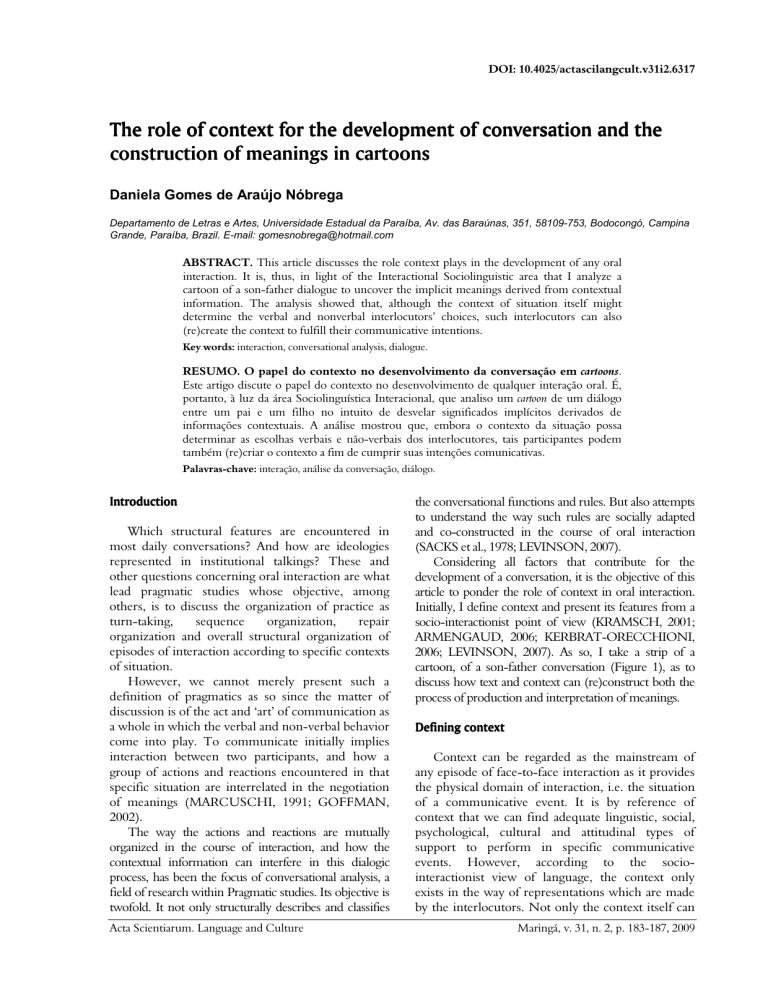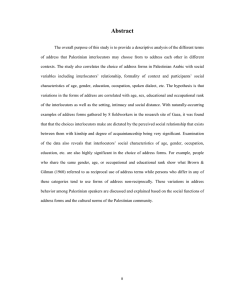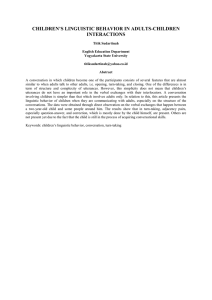
DOI: 10.4025/actascilangcult.v31i2.6317 The role of context for the development of conversation and the construction of meanings in cartoons Daniela Gomes de Araújo Nóbrega Departamento de Letras e Artes, Universidade Estadual da Paraíba, Av. das Baraúnas, 351, 58109-753, Bodocongó, Campina Grande, Paraíba, Brazil. E-mail: gomesnobrega@hotmail.com ABSTRACT. This article discusses the role context plays in the development of any oral interaction. It is, thus, in light of the Interactional Sociolinguistic area that I analyze a cartoon of a son-father dialogue to uncover the implicit meanings derived from contextual information. The analysis showed that, although the context of situation itself might determine the verbal and nonverbal interlocutors’ choices, such interlocutors can also (re)create the context to fulfill their communicative intentions. Key words: interaction, conversational analysis, dialogue. RESUMO. O papel do contexto no desenvolvimento da conversação em cartoons. Este artigo discute o papel do contexto no desenvolvimento de qualquer interação oral. É, portanto, à luz da área Sociolinguística Interacional, que analiso um cartoon de um diálogo entre um pai e um filho no intuito de desvelar significados implícitos derivados de informações contextuais. A análise mostrou que, embora o contexto da situação possa determinar as escolhas verbais e não-verbais dos interlocutores, tais participantes podem também (re)criar o contexto a fim de cumprir suas intenções comunicativas. Palavras-chave: interação, análise da conversação, diálogo. Introduction Introduction Which structural features are encountered in most daily conversations? And how are ideologies represented in institutional talkings? These and other questions concerning oral interaction are what lead pragmatic studies whose objective, among others, is to discuss the organization of practice as turn-taking, sequence organization, repair organization and overall structural organization of episodes of interaction according to specific contexts of situation. However, we cannot merely present such a definition of pragmatics as so since the matter of discussion is of the act and ‘art’ of communication as a whole in which the verbal and non-verbal behavior come into play. To communicate initially implies interaction between two participants, and how a group of actions and reactions encountered in that specific situation are interrelated in the negotiation of meanings (MARCUSCHI, 1991; GOFFMAN, 2002). The way the actions and reactions are mutually organized in the course of interaction, and how the contextual information can interfere in this dialogic process, has been the focus of conversational analysis, a field of research within Pragmatic studies. Its objective is twofold. It not only structurally describes and classifies Acta Scientiarum. Language and Culture the conversational functions and rules. But also attempts to understand the way such rules are socially adapted and co-constructed in the course of oral interaction (SACKS et al., 1978; LEVINSON, 2007). Considering all factors that contribute for the development of a conversation, it is the objective of this article to ponder the role of context in oral interaction. Initially, I define context and present its features from a socio-interactionist point of view (KRAMSCH, 2001; ARMENGAUD, 2006; KERBRAT-ORECCHIONI, 2006; LEVINSON, 2007). As so, I take a strip of a cartoon, of a son-father conversation (Figure 1), as to discuss how text and context can (re)construct both the process of production and interpretation of meanings. Defining context Context can be regarded as the mainstream of any episode of face-to-face interaction as it provides the physical domain of interaction, i.e. the situation of a communicative event. It is by reference of context that we can find adequate linguistic, social, psychological, cultural and attitudinal types of support to perform in specific communicative events. However, according to the sociointeractionist view of language, the context only exists in the way of representations which are made by the interlocutors. Not only the context itself can Maringá, v. 31, n. 2, p. 183-187, 2009 184 lead toward what is going to be said or not in a conversation but also the interlocutors can be in charge of deciding the roles they perform and the consequent linguistic and non-linguistic choices during the interaction (GOFFMAN, 2002; KERBRAT-ORECCHIONI, 2006). Context Context of culture and context of situation Our everyday lives are conducted in situations in which are part of our context of culture, or outer context, and how we signal, perceive and interpret other people’s meanings – as we share the same background knowledge (KRAMSCH, 2001). Moreover, during any conversational episode, we often choose, consciously or unconsciously, appropriate lexical and grammatical language elements accordingly to the context of situation we are involved in. Beyond the linguistic elements needed for language use, the extralinguistic levels of contexts, namely context of culture and of situation, offer guidelines for the interlocutors to perceive and shape context accordingly through their verbal and non-verbal behavior. In this sense, language and context relation is interdependent. It is based on the context of situation and the context of culture that the participants of any interactional event can share their values, expectations, cultural beliefs, i.e. their background knowledge in order to achieve harmony during conversations (WARDHAUGH, 1985). The context of situation guides the interlocutors of social events to talk on the fact as it is, to establish levels of relationships and to choose appropriate text to fulfill the communicative objective (BUTT et al., 1998). These ways of looking into the context of situation is what Halliday calls Field, Tenor and Mood, respectively. The field has to do with the discursive topic itself, the tenor includes the interlocutors’ involvement and the level of relationship among them and the mood is about the channel of communication, i.e. if it is through oral or written discourse to be used, and which adequate style of language should be adopted. It is, then, the context of situation that allows the interlocutors to predict their lexico - grammatical choices which, in turn, signs the syntax and the meanings needed to achieve the dialogue itself. The context of culture is the outer context in which the context of situation is inserted. It deals with shared knowledge, beliefs and social values among the interlocutors from the same culture. This includes the agreement of social conventions from a specific event that only one community embraces. For example, a Greek marriage ceremony is socially organized differently from the Brazilian one. While in the Brazilian ceremony the bride and the groom usually receive their Acta Scientiarum. Language and Culture Nobrega wedding gifts moments before the wedding occurs, for the Greek, gifts are left at the very moment of wedding near the church entrance. This example might provide reasons to show cultural differences in wedding ceremonies, and the consequent actions and reactions these ceremonies demand from the participants involved in. In other words, the context of culture involves the social practice of one particular community used to sharing appropriate verbal and non-verbal behavior (KRAMSCH, 2001; BUTT et al., 1998). Based on an specific context of situation we can decide on what sort of style should be used, if it is formal or informal, and which specific verbal and nonverbal elements should go along with it. In conferences, lectures, court judgments or in any institutions the type of verbal and nonverbal behavior goes along with the formality level of relationship which the context demands. On the other hand, in daily chats among friends, in family talks and at pubs, the type of talk is different since the informal context doesn’t demand to a more sophisticated use of language. Let’s consider, in the dialogue below (Figure 1) between the father and the son, that it is the son who asks to use the father’s car for a while. To achieve such request, the son initially might think that would be hard to get it, as probably he sees himself in a inferior position to his father – the father has the car, he doesn’t. Because of this initial expectation, the son’s non-verbal behavior signals hesitation, doubt on his father’s reaction. As his father’s non-verbal behavior reacts differently from what the son initially expected, the course of interaction turned into in another way. That was established the context of situation and of culture for the rest of the dialogue, though. The dimensions of context To the socio-interactionism, or the socio-pragmatic view of language, the discourse can only be produced and interpreted in the light of concrete communicative situations. This means that context emerges once the interlocutors set the scene of conversation, establish grammatical and lexical choices for the interaction and attempt to speculate about expectations raised in the speaker and the effects s/he wants to cause on the listener. These are called contextual features of communication. According to Searle (apud ARMENGAUD, 2006), meaning is only possible to be conceived, of any sentence, by means of previous propositions also namely contextual propositions which can be identified as presupposition, grammatical and lexical references. Meaning in context, as so, if analyzed from a linguistic dimension, has to do with the co-text. The cotext involves all those linguistic elements which precede Maringá, v. 31, n. 2, p. 183-187, 2009 Context and conversation development in cartoons or follow the dialogue itself and “that ensure the text’s cohesion” (KRAMSCH, 2001, p. 35). Textual features which are common to serve as co-texts are the pronouns, deictic, the referents, parallelism, substitutions and lexical referents, which are often in accordance with the internal context of utterance – the intentions, expectations, assumptions and presuppositions of the interlocutors (KRAMSCH, 2001). The linguistic dimension of context makes us observe language from its structural organization, the initial perspective studied in conversational analysis (KERBRAT-ORECCHIONI, 2006). The use of language can be seen from two ways. On one hand, under the meaning view, it can be observed how the topic is structurally organized and how it can be changed in the course of an interaction. On the other hand, under the form view, it is analyzed the structural organization of the turn-taking systems and the sequences of such turns in order to understand the process of knowledge construction during conversations (TAVARES, 2007; LEVINSON, 2007). For example, in doctor-patient interaction in hospitals, the use of formal personal pronouns and politeness textual features adequate to formal contexts of situations are recurrent. It is the level of interpersonal relationship between the interlocutors that leads to the linguistic choices of a conversation. If a doctor and a patient are relatives, for instance, their way of talking completely differ from a doctor and a patient that see each other for the very first time. Because all aspects of language are interrelated within context, the linguistic dimension of context can only be interpreted by reference of the social dimension. That is, as to interpret what goes on in a conversational episode, we need to take into account the social roles of the interlocutors, when and where they are talking and their level of relationship. To understand ‘who says what to whom in what channel with what effect’, we need to observe the contextual information which surrounds such conversational episode. The social dimension of context refers to the social roles the interlocutors play in a face-to-face encounter and the consequent social variables which might interfere in the development of the interaction. The topic discussed the type of relationship among the interlocutors, the form the message is sent and received, the setting and time of the conversational episode, and the purpose to be achieved are what guide the social dimension of conversations. In a teacher-student college interaction, for instance, the interaction among the interlocutors seems to be more asymmetrical than symmetrical (MARCUSCHI, 1991). When the interlocutors play the same social role, we have the symmetrical interaction, the case of ordinary Acta Scientiarum. Language and Culture 185 conversations between friends. When the interlocutors have social roles determined by institutional places (e.g.: teacher-students college interaction), we have an example of asymmetrical interaction. Both in the production and interpretation of spoken language, as in the example I adopted for the analysis in the following section, the contextual information and its features serve to orient the verbal and non-verbal choices the interlocutor should select in the production and to identify the implicit meaning of the conversation in the interpretation. Therefore, we might say that the relation between context and language is interdependent. The context not only includes the interlocutors’ utterances that precede or follow the spoken sentences but also the setting and time in which the conversation takes place, the participants’ background knowledge, the level of relationship established or constructed, their assumptions on what to speak and how to carry on conversations and the rules of behavior which they tend to adopt in any interactional event (WARDHAUGH, 1985). In a teacher-student college interaction, an example of institutional interaction, teachers tend to assume a more distant relationship towards the students probably because of the institutional role they represent in the classrooms. This is the case of a conditionedoriented interaction. When a friendly atmosphere provided by the teacher breaks the institutional role, that is to say the formality among the students, we have a transformed-oriented interaction (KERBRATORECCHIONI, 2006). If the context provides rules of adequate behavior to establish formality or informality levels of relationships, this will necessarily leads toward the interlocutors’ verbal choices in conversations. Therefore, in analyzing a conversational episode, the discourse analyst should be aware of the contextual information which surrounds the dialogic game among the interlocutors as well as “the beliefs, values and presuppositions that the interlocutors bring to the interactional encounter” (KRAMSCH, 2001, p. 41). It is the notion of shared knowledge among the interlocutors, which can be of ideological nature or not, that context is constructed and the meaning-making process is possible to be uncovered. In the following section, I discuss how the context plays its role in the development of a fatherson dialogue (Figure 1). As so, I analyze to what extent an specific context of situation contributes to the interlocutors’ choices of verbal and nonverbal elements during interaction and its effect on the construction of meaning in a conversational event. Analyzing the strip In order to discuss the relevant role context plays in the development of a son-father dialogue below Maringá, v. 31, n. 2, p. 183-187, 2009 186 (Figure 1), I take into account the topic organization, the sequence of turns organization, the social roles expected in the interaction by the interlocutors, the non-verbal elements used and the implicit purpose to be achieved throughout the dialogue. It is also relevant to mention the time and setting of the dialogue in order to clear out the expected level of relationship between the participants and their type of conversation. To start with, it can be inferred that we are dealing with a son-father dialogue at their home place (Figure 1). As shown in the cartoon (Figure 1), the father is reading or working on his notebook and his son, around his seven or eight years-old, is free to play. I can infer that this dialogue takes place in the evening when the son is not at school or during the weekend. These opposing purposes shown by the interlocutors; the father wants to work and the son wants to play, seem to initially create the interlocutors’ verbal and nonverbal choices in the production and interpretation of this interaction. The language and the gestures used that surrounds the conversation will determine how the discursive topic goes on. It was established, thus, the context of situation. Another aspect to take into account is the use of the computer in this conversation and how it interferes in the course of interaction (Figure 1). Nowadays, we can assume that the computer used at home influence the ways the family members interact to each other. Either used for pleasure or work purposes, the computer is usually managed by one person. As a result, the individualism increases making the family members more distant from themselves for any conversational encounter. This specific context of culture (the presence of the computer in family relations) seems, at first sight, to narrow down the type of relationship to be established in the interactional episode. In the cartoon, the father tends to assume this individual position, particularly when expressing himself by saying ‘Humm’ when his son approaches. It might be inferred, thus, that he doesn’t want to talk at that very moment and the prosodic element gives emphasis to it. Another aspect is the development of the discursive topic. Initially, it might be said that the son is trying to ask something to the father who seems to be busy, possibly working or reading on his notebook (Figure 1). As so, the son starts his speech by requesting ‘Dad, are you listening to me?’ (Figure 1) checking out his father’s attention. In this question, the son might be expecting his father to allow him or not for what he wants to say, which is the topic of the whole conversation: to take his father’s car to use for a while in saying ‘Can you lend me your car?’(Figure 1) If we consider what goes on in a father and son’s organizational structure of conversation under these circumstances, we probably assume that it is Acta Scientiarum. Language and Culture Nobrega the father who decides what the son should do, who listens to sons whenever they need. The tendency of most turn-taking systems of this type of relationship indicates the father as the leading voice, guiding the development of the topic. The sequence of turns in this dialogue seems to be of a different type considering the role the father and the son are adopting at that moment, providing as a result a symmetric relation between them (MARCUSCHI, 1991). Probably, when a son asks a direct question to the father to do something, there is a yes or no answer following it along with some further comment or words of advice from the father. In this case, the father seems to be ignoring the son’s request by sounding ‘Uhum’ possibly meaning that whatever the request is, he seems not to be interested at all. As the cartoon shows, the Dad is busy. By doing so, it can be inferred that the father changes his social role in the dialogue as a person who decides what the son has to do or not, making the son be in charge of his own decision. The sequence of turns, therefore, might represent two interpretations. To the father’s side, the lack of a yes or no question, he probably wants his son to see that he is busy and doesn’t want to be disturbed. The prosody ‘Uhum’ might indicate that. To the son’s side, the father’s reaction might mean that his request can be accepted. Another feature that might deserve attention in this conversation is the non-verbal element: the gestures. Gestures along with the linguistic element, which is the direct question used by the son, can reinforce the intentions and expectations of the interlocutor according to the interlocutor’s response (GOFFMAN, 2002). In this case, the first son’s eye gesture seems to correspond to his uncertainty about his father’s reaction on his desire to take the car for use. Once observing that his father was not attentive to his question ‘Can you lend me your car’, probably because of his father’s reply ‘Humm’, the boy’s eye gesture along with his smile take another position; of satisfaction as shown in the second picture. www.tirasdoedu.com.br 2007 © DIRCEU VEIGA Figure 1. Edi’s charges. What it follows in the last picture seems to be the result of the real interlocutor’s perception (the son) according to the reactions provided by the other interlocutor (the father). The son automatically got to use the car – represented by VRUUUUMMM, the sound of the car - thinking that it was the father Maringá, v. 31, n. 2, p. 183-187, 2009 Context and conversation development in cartoons who allowed him to use it. This could be implied by the mother’s voice as in ‘EDI, turn off this car already!’ In fact, as expected by the son, his father did not pay any attention to his request as in repeating the same answer ‘Uhum’. In this dialogue (Figure 1), we can infer that it was according to the son’s perceptions and expectations about the father and son interaction in requests that the interaction developed. In here, we might assume that the context of situation provided informational cues for the realization of the interaction. The level of relationship, which was of a different perspective – we often find fathers answering whether the son can or cannot do things at home – established a different son’s social role, that of deciding what to do. However, the conflict that appeared through the mother’s voice, was that of establishing the culturally accepted level of relationship between the father and the son: the parents’ decision on what the sons should do at home. Conclusion The role of context in oral interaction discussed in this article is just one of the conversational features among many others that conversational analysts can choose as the basis for investigating the implicit meanings in dialogues. This article was an attempt to analyze to what extent contextual information can contribute to the interlocutors’ choices of nonverbal and verbal elements and to the development of any conversational episode such as the dialogue presented in this article. That’s why, we should consider context as a product of a variety of informational aspects which creates the scene for the interaction. In this analysis we can conclude that the context of situation was modified through the son’s perception of his father’s behavior. As in most family relations, it is culturally accepted that it is the father who decides what a seven year-old boy should in relation to the father’s cars. The lack of attention shown by the father in relation to his son’s requirement could provide contextual information to the change of social role to be established in the dialogue. As a result, the son’s perceptions and his nonverbal behavior were of great value to modify the Acta Scientiarum. Language and Culture 187 context to fulfill his intention. That’s why, as Kramsch (2001, p. 46) says “Context is the matrix created by language as discourse and as a form of social practice”. As so, this social product of linguistic and nonlinguistic choices “[…] in turn hold together, control, manipulate, and maintain the social order, that is, the social organization of classrooms, homes , and workplaces” (KRAMSCH, 2001, p. 46). References ARMENGAUD, F. A Pragmática. Tradução Marcos Marcionilo. São Paulo: Parábola Editorial, 2006. BUTT, D.; FAHEY, R.; SPINKS, S.; YALLOP, C. Using functional grammar: an explorer guide. Sydney: Macquarie University, 1998. GOFFMAN, E. A situação negligenciada. In: RIBEIRO, B. T.; GARCEZ, P. M. (Org.). Sociolingüística interacional. 2. ed. São Paulo: Loyola, 2002. p. 13-20. KRAMSCH, C. Contexts of speech and social interaction. In: KRAMSCH, C. (Ed.). Context of culture in language teaching. Oxford: Oxford University Press, 2001. p. 34-69. KERBRAT-ORECCHIONI, C. Análise da conversação: princípios e métodos. Tradução Carlos Piovezani Filho. São Paulo: Parábola, 2006. LEVINSON, S. C. Pragmática. Tradução Luis Carlos Borges e Aníbal Mari. Revisão da tradução Rodolfo Ilari. São Paulo: Martins Fontes, 2007. MARCUSCHI, L. A. Análise da conversação. 2. ed. São Paulo: Ática, 1991. SACKS, H.; SCHEGLOFF, E.; JEFFERSON, G. A simplest systematics for the organization of turn taking for conversation. In: SCHENKEIN, J. (Ed.). Studies in the organization of conversational interaction. New York: Academic Press, 1978. p. 7-55. TAVARES, R. R. A negociação da imagem na pragmática: por uma visão sociointeracionista da linguagem. Maceió: Edufal, 2007. WARDHAUGH, R. How conversation works. Oxford: Basil Blackwell, 1985. Received on February 10, 2009. Accepted on May 14, 2009. License information: This is an open-access article distributed under the terms of the Creative Commons Attribution License, which permits unrestricted use, distribution, and reproduction in any medium, provided the original work is properly cited. Maringá, v. 31, n. 2, p. 183-187, 2009





